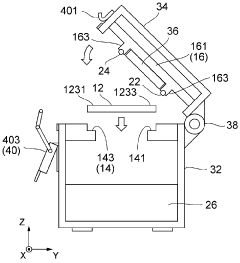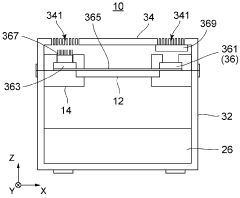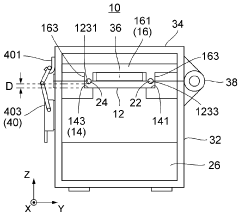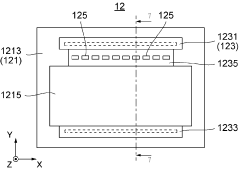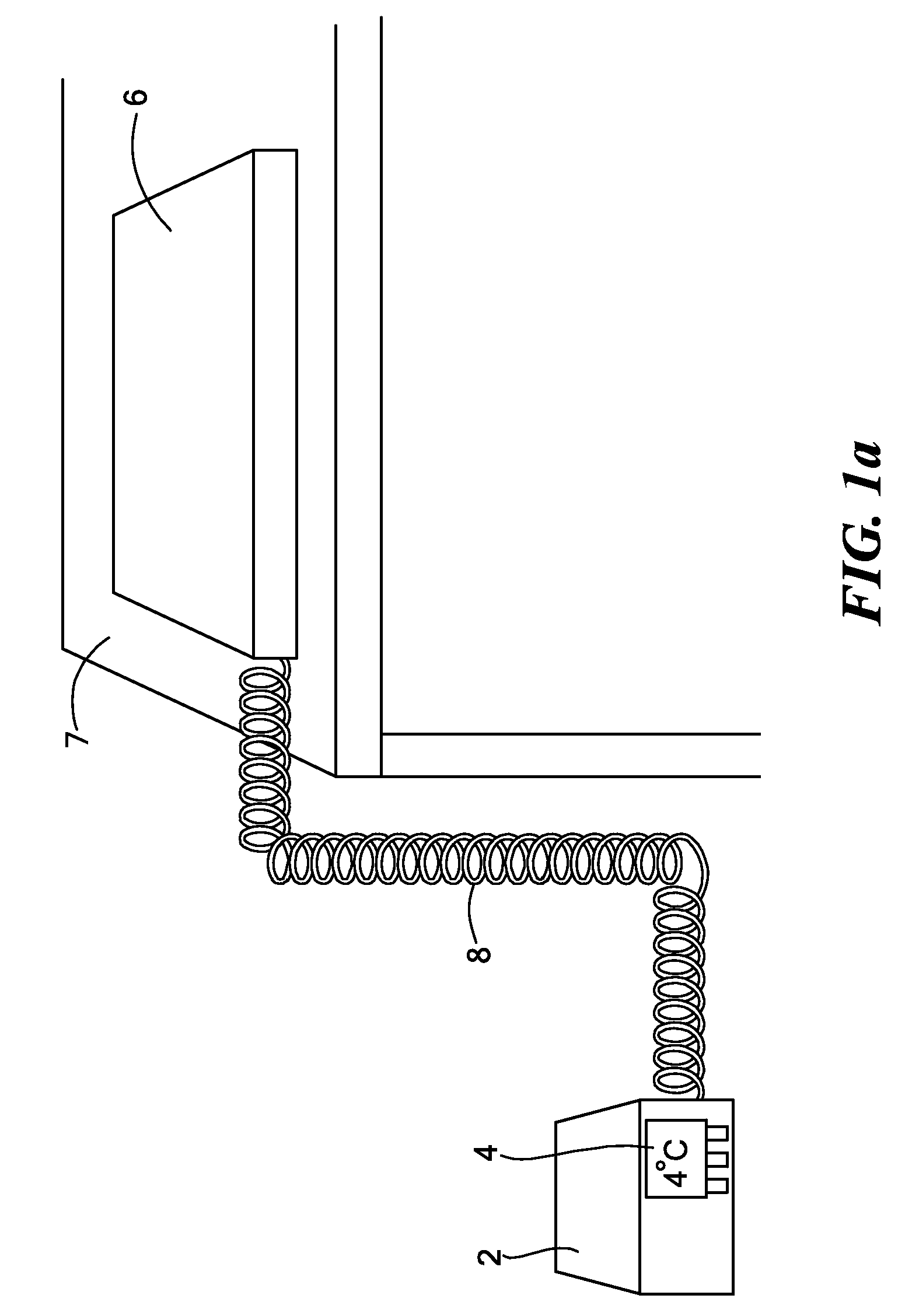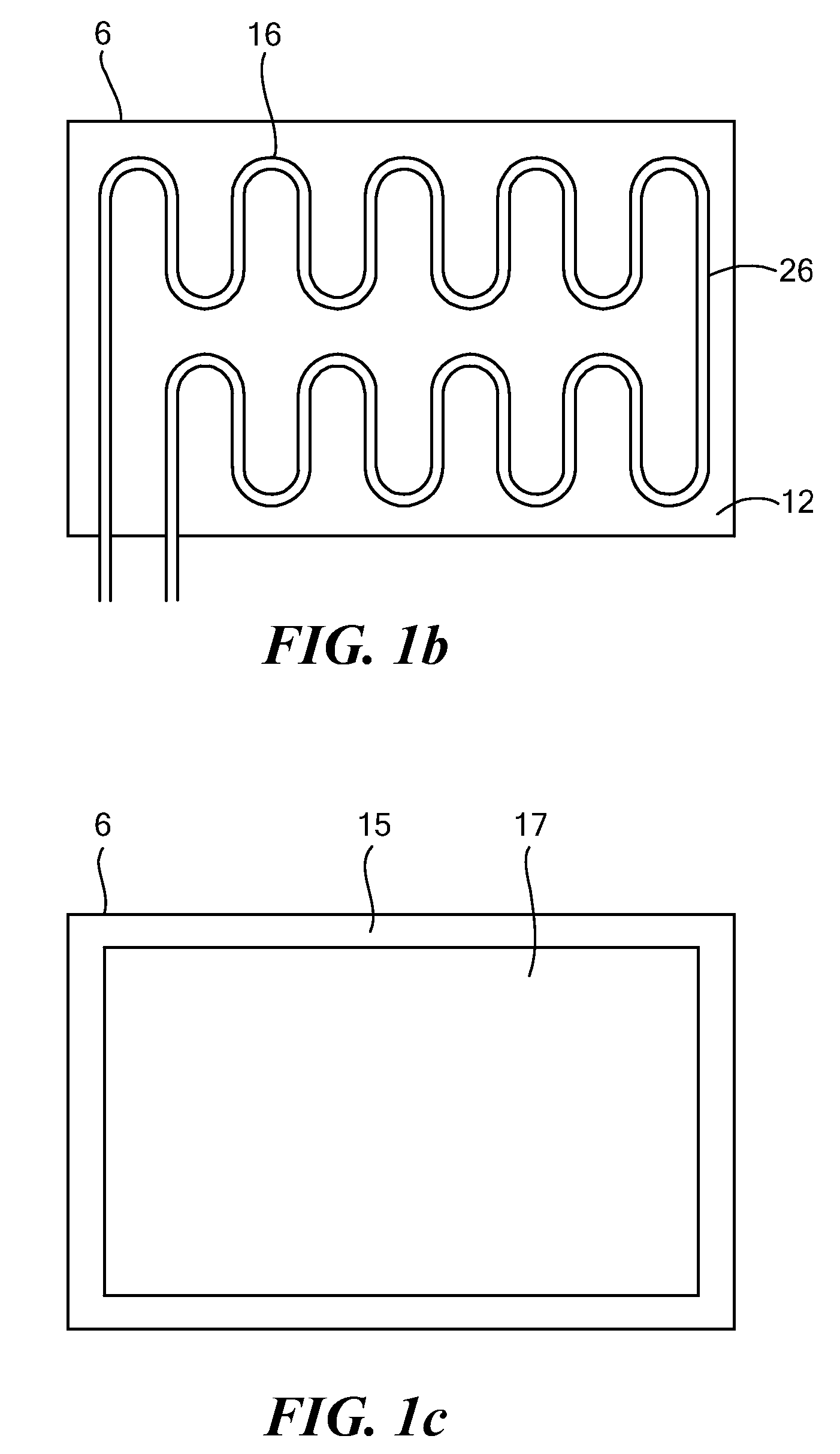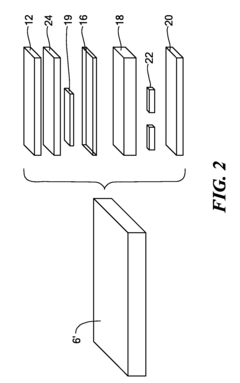How to Minimize Eco-Footprint in Gel Electrophoresis?
JUN 30, 202510 MIN READ
Generate Your Research Report Instantly with AI Agent
Patsnap Eureka helps you evaluate technical feasibility & market potential.
Gel Electrophoresis Eco-Challenges and Objectives
Gel electrophoresis is a fundamental technique in molecular biology, widely used for separating and analyzing DNA, RNA, and proteins. However, its environmental impact has become a growing concern in recent years. The primary objective of minimizing the eco-footprint in gel electrophoresis is to develop sustainable practices that reduce waste, conserve resources, and minimize the use of harmful chemicals while maintaining the technique's efficacy and reliability.
The evolution of gel electrophoresis technology has seen significant advancements since its inception in the 1930s. From the early use of starch gels to the development of polyacrylamide and agarose gels, the technique has continuously improved in terms of resolution and applicability. However, these improvements have not always considered environmental sustainability, leading to the current challenges faced by the scientific community.
One of the main environmental concerns in gel electrophoresis is the use of toxic chemicals, particularly ethidium bromide, a common DNA staining agent. This mutagen poses risks to both researchers and the environment when disposed of improperly. Additionally, the production and disposal of single-use plastic consumables, such as gel trays and combs, contribute significantly to laboratory waste.
The high water consumption in gel preparation and electrophoresis buffer systems is another eco-challenge that needs addressing. Furthermore, the energy consumption of electrophoresis power supplies and imaging systems adds to the overall environmental impact of the technique.
To tackle these challenges, several objectives have been set for minimizing the eco-footprint of gel electrophoresis. These include developing safer alternatives to hazardous chemicals, implementing recycling programs for plastic consumables, optimizing protocols to reduce water and energy consumption, and exploring novel, more sustainable gel matrix materials.
Another key objective is to improve the efficiency of the electrophoresis process itself, potentially reducing the number of runs required and, consequently, the resources consumed. This may involve enhancing separation resolution or developing multiplex techniques that allow for the analysis of multiple samples simultaneously.
The scientific community is also focusing on the integration of green chemistry principles into gel electrophoresis protocols. This approach aims to design chemical products and processes that reduce or eliminate the use and generation of hazardous substances, aligning with the broader goals of sustainable laboratory practices.
As research institutions and biotechnology companies increasingly prioritize sustainability, the development of eco-friendly gel electrophoresis techniques has become a significant area of interest. The ultimate goal is to create a balance between scientific progress and environmental responsibility, ensuring that this crucial analytical technique can continue to support groundbreaking research while minimizing its ecological impact.
The evolution of gel electrophoresis technology has seen significant advancements since its inception in the 1930s. From the early use of starch gels to the development of polyacrylamide and agarose gels, the technique has continuously improved in terms of resolution and applicability. However, these improvements have not always considered environmental sustainability, leading to the current challenges faced by the scientific community.
One of the main environmental concerns in gel electrophoresis is the use of toxic chemicals, particularly ethidium bromide, a common DNA staining agent. This mutagen poses risks to both researchers and the environment when disposed of improperly. Additionally, the production and disposal of single-use plastic consumables, such as gel trays and combs, contribute significantly to laboratory waste.
The high water consumption in gel preparation and electrophoresis buffer systems is another eco-challenge that needs addressing. Furthermore, the energy consumption of electrophoresis power supplies and imaging systems adds to the overall environmental impact of the technique.
To tackle these challenges, several objectives have been set for minimizing the eco-footprint of gel electrophoresis. These include developing safer alternatives to hazardous chemicals, implementing recycling programs for plastic consumables, optimizing protocols to reduce water and energy consumption, and exploring novel, more sustainable gel matrix materials.
Another key objective is to improve the efficiency of the electrophoresis process itself, potentially reducing the number of runs required and, consequently, the resources consumed. This may involve enhancing separation resolution or developing multiplex techniques that allow for the analysis of multiple samples simultaneously.
The scientific community is also focusing on the integration of green chemistry principles into gel electrophoresis protocols. This approach aims to design chemical products and processes that reduce or eliminate the use and generation of hazardous substances, aligning with the broader goals of sustainable laboratory practices.
As research institutions and biotechnology companies increasingly prioritize sustainability, the development of eco-friendly gel electrophoresis techniques has become a significant area of interest. The ultimate goal is to create a balance between scientific progress and environmental responsibility, ensuring that this crucial analytical technique can continue to support groundbreaking research while minimizing its ecological impact.
Market Demand for Sustainable Lab Techniques
The demand for sustainable laboratory techniques has been steadily increasing in recent years, driven by growing environmental awareness and the need for cost-effective solutions in research institutions and biotechnology companies. Gel electrophoresis, a fundamental technique in molecular biology, has come under scrutiny due to its significant environmental impact and resource consumption. This has created a substantial market opportunity for eco-friendly alternatives and improvements to traditional gel electrophoresis methods.
Research institutions and universities, which constitute a large portion of the gel electrophoresis market, are increasingly adopting sustainability policies and seeking ways to reduce their ecological footprint. This shift is partly due to pressure from funding bodies and regulatory agencies to demonstrate environmental responsibility. As a result, there is a growing demand for gel electrophoresis systems and consumables that minimize waste, reduce energy consumption, and utilize more sustainable materials.
The biotechnology and pharmaceutical industries are also key drivers of this market trend. These sectors are not only looking to improve their environmental credentials but also to reduce operational costs associated with waste disposal and energy use. The adoption of sustainable lab techniques can lead to significant long-term savings, making it an attractive proposition for companies of all sizes.
Market analysis indicates that the global gel electrophoresis market is expected to grow substantially in the coming years, with a significant portion of this growth attributed to the demand for more sustainable options. Manufacturers of lab equipment and consumables are responding to this trend by developing new products that address environmental concerns while maintaining or improving performance.
One area of particular interest is the development of alternatives to traditional polyacrylamide and agarose gels, which are non-biodegradable and often contain toxic components. There is a growing market for biodegradable gel matrices and safer staining methods that reduce the use of hazardous chemicals. Additionally, there is increasing demand for more efficient electrophoresis systems that consume less power and produce less heat, thereby reducing energy waste.
The market is also seeing a rise in demand for miniaturized gel electrophoresis systems, which not only reduce the ecological impact but also offer advantages in terms of speed and sample conservation. These systems are particularly appealing to laboratories with limited space and resources, as well as those conducting high-throughput analyses.
Furthermore, there is a growing market for services and consultancy related to implementing sustainable lab practices, including optimizing gel electrophoresis protocols to minimize waste and energy use. This reflects a broader trend towards sustainability in scientific research and development, with laboratories seeking expert guidance on how to reduce their environmental impact across all operations.
Research institutions and universities, which constitute a large portion of the gel electrophoresis market, are increasingly adopting sustainability policies and seeking ways to reduce their ecological footprint. This shift is partly due to pressure from funding bodies and regulatory agencies to demonstrate environmental responsibility. As a result, there is a growing demand for gel electrophoresis systems and consumables that minimize waste, reduce energy consumption, and utilize more sustainable materials.
The biotechnology and pharmaceutical industries are also key drivers of this market trend. These sectors are not only looking to improve their environmental credentials but also to reduce operational costs associated with waste disposal and energy use. The adoption of sustainable lab techniques can lead to significant long-term savings, making it an attractive proposition for companies of all sizes.
Market analysis indicates that the global gel electrophoresis market is expected to grow substantially in the coming years, with a significant portion of this growth attributed to the demand for more sustainable options. Manufacturers of lab equipment and consumables are responding to this trend by developing new products that address environmental concerns while maintaining or improving performance.
One area of particular interest is the development of alternatives to traditional polyacrylamide and agarose gels, which are non-biodegradable and often contain toxic components. There is a growing market for biodegradable gel matrices and safer staining methods that reduce the use of hazardous chemicals. Additionally, there is increasing demand for more efficient electrophoresis systems that consume less power and produce less heat, thereby reducing energy waste.
The market is also seeing a rise in demand for miniaturized gel electrophoresis systems, which not only reduce the ecological impact but also offer advantages in terms of speed and sample conservation. These systems are particularly appealing to laboratories with limited space and resources, as well as those conducting high-throughput analyses.
Furthermore, there is a growing market for services and consultancy related to implementing sustainable lab practices, including optimizing gel electrophoresis protocols to minimize waste and energy use. This reflects a broader trend towards sustainability in scientific research and development, with laboratories seeking expert guidance on how to reduce their environmental impact across all operations.
Current State of Eco-Friendly Gel Electrophoresis
Gel electrophoresis, a fundamental technique in molecular biology, has been under scrutiny for its environmental impact. In recent years, significant strides have been made towards developing eco-friendly alternatives and improving existing methods to minimize the ecological footprint of this widely used laboratory procedure.
One of the primary focuses has been on reducing the use of toxic chemicals traditionally employed in gel electrophoresis. Researchers have successfully developed and implemented safer alternatives to ethidium bromide, a common DNA stain with mutagenic properties. Non-toxic fluorescent dyes such as SYBR Safe and GelRed have gained popularity, offering comparable sensitivity while significantly reducing environmental and health risks.
Another area of improvement lies in the gel matrix itself. Conventional agarose gels, derived from seaweed, have a considerable environmental cost due to their single-use nature and the energy-intensive production process. To address this, biodegradable and recyclable gel alternatives have emerged. For instance, polyacrylamide-based hydrogels that can be dissolved and reused have shown promise in reducing waste generation.
Water consumption in gel electrophoresis has also been targeted for reduction. Novel buffer systems that require less frequent changes and microfluidic devices that operate with minimal buffer volumes have been developed. These innovations not only conserve water but also reduce the amount of potentially harmful chemicals released into the environment.
Energy efficiency has been another key area of focus. Traditional gel electrophoresis systems consume significant amounts of electricity, particularly during extended run times. New low-voltage systems and optimized power supplies have been introduced, offering comparable separation quality while reducing energy consumption. Additionally, the integration of LED light sources for gel visualization has further decreased the overall energy footprint of the technique.
Waste management strategies have evolved to complement these technological advancements. Many laboratories now implement proper disposal protocols for gels and buffers, including neutralization and filtration processes before disposal. Some institutions have adopted centralized waste management systems specifically designed for electrophoresis materials, ensuring proper handling and minimizing environmental impact.
The current state of eco-friendly gel electrophoresis also reflects a growing awareness and commitment from manufacturers. Many companies now offer product lines specifically designed with sustainability in mind, incorporating recyclable materials in packaging and providing detailed guidelines for environmentally responsible use and disposal of their products.
While significant progress has been made, challenges remain in widespread adoption of these eco-friendly practices. Cost considerations, the need for protocol optimization, and resistance to change in established laboratory procedures are some of the hurdles that continue to be addressed. However, the trend towards more sustainable gel electrophoresis practices is clear and gaining momentum across the scientific community.
One of the primary focuses has been on reducing the use of toxic chemicals traditionally employed in gel electrophoresis. Researchers have successfully developed and implemented safer alternatives to ethidium bromide, a common DNA stain with mutagenic properties. Non-toxic fluorescent dyes such as SYBR Safe and GelRed have gained popularity, offering comparable sensitivity while significantly reducing environmental and health risks.
Another area of improvement lies in the gel matrix itself. Conventional agarose gels, derived from seaweed, have a considerable environmental cost due to their single-use nature and the energy-intensive production process. To address this, biodegradable and recyclable gel alternatives have emerged. For instance, polyacrylamide-based hydrogels that can be dissolved and reused have shown promise in reducing waste generation.
Water consumption in gel electrophoresis has also been targeted for reduction. Novel buffer systems that require less frequent changes and microfluidic devices that operate with minimal buffer volumes have been developed. These innovations not only conserve water but also reduce the amount of potentially harmful chemicals released into the environment.
Energy efficiency has been another key area of focus. Traditional gel electrophoresis systems consume significant amounts of electricity, particularly during extended run times. New low-voltage systems and optimized power supplies have been introduced, offering comparable separation quality while reducing energy consumption. Additionally, the integration of LED light sources for gel visualization has further decreased the overall energy footprint of the technique.
Waste management strategies have evolved to complement these technological advancements. Many laboratories now implement proper disposal protocols for gels and buffers, including neutralization and filtration processes before disposal. Some institutions have adopted centralized waste management systems specifically designed for electrophoresis materials, ensuring proper handling and minimizing environmental impact.
The current state of eco-friendly gel electrophoresis also reflects a growing awareness and commitment from manufacturers. Many companies now offer product lines specifically designed with sustainability in mind, incorporating recyclable materials in packaging and providing detailed guidelines for environmentally responsible use and disposal of their products.
While significant progress has been made, challenges remain in widespread adoption of these eco-friendly practices. Cost considerations, the need for protocol optimization, and resistance to change in established laboratory procedures are some of the hurdles that continue to be addressed. However, the trend towards more sustainable gel electrophoresis practices is clear and gaining momentum across the scientific community.
Existing Eco-Solutions in Gel Electrophoresis
01 Eco-friendly gel materials
Development of biodegradable and environmentally friendly gel materials for electrophoresis to reduce the ecological footprint. These materials are designed to be less harmful to the environment when disposed of and may include natural polymers or sustainable synthetic alternatives.- Eco-friendly gel materials: Development of biodegradable and environmentally friendly gel materials for electrophoresis to reduce the ecological footprint. These materials are designed to be less harmful to the environment when disposed of and may include natural polymers or modified synthetic materials that break down more easily.
- Energy-efficient electrophoresis systems: Implementation of energy-saving technologies in gel electrophoresis equipment to minimize power consumption. This includes the use of low-voltage systems, improved cooling mechanisms, and optimized electrode designs that reduce the overall energy requirements of the electrophoresis process.
- Miniaturization and microfluidic devices: Development of miniaturized gel electrophoresis systems and microfluidic devices that require smaller sample volumes and less reagents. These compact systems not only reduce waste but also decrease the overall environmental impact by minimizing the use of materials and energy.
- Reusable and recyclable components: Design of gel electrophoresis systems with reusable or recyclable components to reduce waste generation. This includes the development of washable gel cassettes, reusable buffer chambers, and recyclable electrode materials that can be used multiple times before disposal.
- Sustainable buffer and reagent solutions: Formulation of eco-friendly buffer and reagent solutions for gel electrophoresis that are less toxic and more easily treatable. This involves the use of biodegradable chemicals, reduced concentrations of harmful substances, and the development of alternative staining methods that minimize environmental impact.
02 Energy-efficient electrophoresis systems
Implementation of energy-saving technologies in gel electrophoresis equipment to minimize power consumption. This includes the use of low-voltage systems, improved cooling mechanisms, and optimized electrode designs to reduce the overall energy footprint of the process.Expand Specific Solutions03 Miniaturization and microfluidic approaches
Adoption of miniaturized gel electrophoresis systems and microfluidic devices to reduce reagent consumption and waste generation. These approaches allow for smaller sample volumes and decreased use of potentially harmful chemicals, contributing to a reduced environmental impact.Expand Specific Solutions04 Recycling and reuse of electrophoresis components
Development of methods for recycling and reusing gel materials, buffers, and other components used in electrophoresis. This includes strategies for purifying and regenerating used materials, as well as designing reusable gel cassettes and other hardware to minimize waste.Expand Specific Solutions05 Alternative separation techniques
Exploration of alternative separation techniques that can complement or replace traditional gel electrophoresis, potentially offering lower environmental impact. These may include capillary electrophoresis, paper-based systems, or other novel approaches that reduce resource consumption and waste generation.Expand Specific Solutions
Key Players in Sustainable Lab Equipment
The eco-footprint minimization in gel electrophoresis is an emerging focus in the biotechnology industry, reflecting the sector's early-stage transition towards sustainability. While the market size for eco-friendly gel electrophoresis solutions is still developing, it presents significant growth potential as environmental concerns gain prominence. Technologically, the field is in its nascent stages, with companies like Life Technologies Corp. and Ventana Medical Systems leading innovation efforts. Other players such as Pierce Biotechnology and Sage Science are also contributing to advancements, though the overall technology maturity remains moderate. As research institutions like Oregon Health & Science University collaborate with industry partners, we can expect accelerated progress in eco-friendly gel electrophoresis techniques in the coming years.
Life Technologies Corp.
Technical Solution: Life Technologies Corp. has developed innovative solutions to minimize the eco-footprint in gel electrophoresis. Their approach includes the use of pre-cast gels, which reduce waste and improve consistency. They have also introduced low-toxicity staining alternatives to ethidium bromide, such as SYBR Safe DNA gel stain, which is less hazardous and can be disposed of more easily[1]. The company has implemented a buffer recycling system that allows for the reuse of electrophoresis buffers, significantly reducing water consumption and chemical waste[2]. Additionally, they have developed more energy-efficient power supplies that consume up to 30% less electricity compared to traditional models[3].
Strengths: Reduced chemical waste, lower toxicity, improved energy efficiency, and decreased water consumption. Weaknesses: Potentially higher initial costs for specialized equipment and materials, may require staff training for new protocols.
Sage Science, Inc.
Technical Solution: Sage Science, Inc. has pioneered automated gel electrophoresis systems that significantly reduce the environmental impact of the process. Their Pippin Prep and BluePippin systems use disposable cassettes with pre-cast agarose gels, minimizing gel preparation waste and exposure to harmful chemicals[4]. These systems operate with minimal buffer volumes, reducing chemical usage by up to 90% compared to traditional methods[5]. Sage Science has also developed a gel extraction technology that eliminates the need for toxic organic solvents, such as ethidium bromide, in DNA purification processes[6]. Their systems are designed for high efficiency, reducing run times and energy consumption by up to 75% compared to conventional gel electrophoresis methods[7].
Strengths: Significant reduction in chemical waste and energy consumption, improved safety for lab personnel, and increased reproducibility. Weaknesses: Higher upfront costs for specialized equipment, limited to specific applications, and potential dependence on proprietary consumables.
Innovations in Low-Impact Electrophoresis
Gel electrophoresis device
PatentWO2024122250A1
Innovation
- A gel electrophoresis device design that presses electrodes directly onto the gel cassette to form a uniform electric field without additional buffers, using a gel cassette without integrated electrodes, which reduces costs and environmental impact by eliminating the need for additional buffer solutions and addressing surface irregularities.
Laboratory Temperature Control With Ultra-Smooth Heat Transfer Surfaces
PatentInactiveUS20080029248A1
Innovation
- A temperature regulation system with a polished surface of low emissivity, integrated with a miniature rotary compressor and a refrigeration assembly, which circulates coolant fluid to efficiently transfer heat away from the electrophoresis buffer, maintaining a stable temperature and allowing higher voltage applications.
Environmental Regulations in Laboratory Practices
Environmental regulations in laboratory practices have become increasingly stringent in recent years, particularly concerning gel electrophoresis techniques. These regulations aim to minimize the ecological impact of laboratory procedures and promote sustainable scientific practices. The Environmental Protection Agency (EPA) and other regulatory bodies have established guidelines for the proper handling, storage, and disposal of chemicals and materials used in gel electrophoresis.
One of the primary concerns addressed by these regulations is the management of hazardous waste generated during the electrophoresis process. Laboratories are required to implement proper waste segregation and disposal protocols for acrylamide, ethidium bromide, and other potentially harmful substances. Many institutions have adopted centralized waste collection systems and specialized treatment facilities to ensure compliance with environmental standards.
The use of toxic chemicals in gel electrophoresis has also come under scrutiny. Regulations now encourage the substitution of traditional staining agents with more environmentally friendly alternatives. For instance, SYBR Safe and GelRed have gained popularity as less toxic replacements for ethidium bromide. Additionally, guidelines promote the use of lower concentrations of these chemicals when possible, further reducing environmental impact.
Water conservation has become another focal point of laboratory regulations. Many institutions have implemented policies to minimize water usage in gel electrophoresis procedures, including the recycling of buffer solutions and the adoption of more efficient cooling systems. Some regulations also mandate the treatment of wastewater from electrophoresis equipment before release into the general sewage system.
Energy efficiency is an increasingly important aspect of environmental regulations in laboratory practices. Guidelines now encourage the use of energy-efficient electrophoresis equipment and power supplies. Many institutions have implemented policies to turn off equipment when not in use and optimize run times to reduce overall energy consumption.
Packaging and material waste associated with gel electrophoresis supplies have also been addressed in recent regulations. There is a growing emphasis on using recyclable or biodegradable materials for gel trays, combs, and other disposable components. Some institutions have implemented take-back programs for certain types of laboratory plastics, ensuring proper recycling or disposal.
Compliance with these environmental regulations often requires laboratories to maintain detailed records of chemical usage, waste generation, and disposal practices. Regular audits and inspections are conducted to ensure adherence to these guidelines. Many institutions have established environmental health and safety departments to oversee compliance and provide training to laboratory personnel on best practices for minimizing ecological impact.
As environmental concerns continue to grow, it is likely that regulations governing laboratory practices, including gel electrophoresis, will become even more stringent in the future. Researchers and laboratory managers must stay informed about these evolving regulations and adapt their practices accordingly to ensure both scientific progress and environmental responsibility.
One of the primary concerns addressed by these regulations is the management of hazardous waste generated during the electrophoresis process. Laboratories are required to implement proper waste segregation and disposal protocols for acrylamide, ethidium bromide, and other potentially harmful substances. Many institutions have adopted centralized waste collection systems and specialized treatment facilities to ensure compliance with environmental standards.
The use of toxic chemicals in gel electrophoresis has also come under scrutiny. Regulations now encourage the substitution of traditional staining agents with more environmentally friendly alternatives. For instance, SYBR Safe and GelRed have gained popularity as less toxic replacements for ethidium bromide. Additionally, guidelines promote the use of lower concentrations of these chemicals when possible, further reducing environmental impact.
Water conservation has become another focal point of laboratory regulations. Many institutions have implemented policies to minimize water usage in gel electrophoresis procedures, including the recycling of buffer solutions and the adoption of more efficient cooling systems. Some regulations also mandate the treatment of wastewater from electrophoresis equipment before release into the general sewage system.
Energy efficiency is an increasingly important aspect of environmental regulations in laboratory practices. Guidelines now encourage the use of energy-efficient electrophoresis equipment and power supplies. Many institutions have implemented policies to turn off equipment when not in use and optimize run times to reduce overall energy consumption.
Packaging and material waste associated with gel electrophoresis supplies have also been addressed in recent regulations. There is a growing emphasis on using recyclable or biodegradable materials for gel trays, combs, and other disposable components. Some institutions have implemented take-back programs for certain types of laboratory plastics, ensuring proper recycling or disposal.
Compliance with these environmental regulations often requires laboratories to maintain detailed records of chemical usage, waste generation, and disposal practices. Regular audits and inspections are conducted to ensure adherence to these guidelines. Many institutions have established environmental health and safety departments to oversee compliance and provide training to laboratory personnel on best practices for minimizing ecological impact.
As environmental concerns continue to grow, it is likely that regulations governing laboratory practices, including gel electrophoresis, will become even more stringent in the future. Researchers and laboratory managers must stay informed about these evolving regulations and adapt their practices accordingly to ensure both scientific progress and environmental responsibility.
Life Cycle Assessment of Electrophoresis Materials
Life Cycle Assessment (LCA) of electrophoresis materials is a crucial step in understanding and minimizing the environmental impact of gel electrophoresis techniques. This assessment encompasses the entire lifecycle of materials used in the process, from raw material extraction to disposal or recycling.
The primary materials involved in gel electrophoresis include agarose or polyacrylamide gels, buffer solutions, and various plastic consumables. Each of these components contributes to the overall environmental footprint of the technique. Agarose, derived from seaweed, has a relatively low environmental impact during production but may contribute to marine ecosystem disruption if not sourced sustainably.
Polyacrylamide gels, on the other hand, are synthetic and require more energy-intensive manufacturing processes. The production of acrylamide monomers and their polymerization involves chemical reactions that can generate hazardous byproducts. Buffer solutions, typically containing Tris, boric acid, and EDTA, also have environmental implications due to their chemical nature and disposal requirements.
Plastic consumables, such as gel trays, combs, and electrophoresis chambers, represent a significant portion of the waste generated in laboratories. These items are often single-use and contribute to the growing problem of plastic pollution. The production of these plastics involves petroleum-based processes, further adding to the carbon footprint of the technique.
The energy consumption during the electrophoresis process itself is another factor to consider in the LCA. Power supplies and cooling systems used in electrophoresis contribute to electricity usage and associated carbon emissions. The duration and frequency of runs can significantly impact the overall energy consumption of a laboratory.
Disposal and end-of-life considerations for electrophoresis materials are critical aspects of their life cycle assessment. Gels contaminated with ethidium bromide or other DNA stains require special handling and disposal procedures due to their potential mutagenicity. Proper disposal methods, such as chemical decontamination or incineration, add to the environmental cost of the technique.
Recycling opportunities for electrophoresis materials are limited but growing. Some plastic consumables can be recycled if properly cleaned and sorted. However, the majority of materials end up in landfills or are incinerated, contributing to greenhouse gas emissions and potential soil and water contamination.
By conducting a comprehensive LCA of electrophoresis materials, researchers and manufacturers can identify hotspots in the lifecycle where environmental impact is highest. This information can guide the development of more sustainable alternatives, such as bio-based gels, reusable plastic components, or more energy-efficient electrophoresis systems. Additionally, it can inform best practices for material use, waste reduction, and disposal in laboratory settings, ultimately contributing to a reduced eco-footprint in gel electrophoresis techniques.
The primary materials involved in gel electrophoresis include agarose or polyacrylamide gels, buffer solutions, and various plastic consumables. Each of these components contributes to the overall environmental footprint of the technique. Agarose, derived from seaweed, has a relatively low environmental impact during production but may contribute to marine ecosystem disruption if not sourced sustainably.
Polyacrylamide gels, on the other hand, are synthetic and require more energy-intensive manufacturing processes. The production of acrylamide monomers and their polymerization involves chemical reactions that can generate hazardous byproducts. Buffer solutions, typically containing Tris, boric acid, and EDTA, also have environmental implications due to their chemical nature and disposal requirements.
Plastic consumables, such as gel trays, combs, and electrophoresis chambers, represent a significant portion of the waste generated in laboratories. These items are often single-use and contribute to the growing problem of plastic pollution. The production of these plastics involves petroleum-based processes, further adding to the carbon footprint of the technique.
The energy consumption during the electrophoresis process itself is another factor to consider in the LCA. Power supplies and cooling systems used in electrophoresis contribute to electricity usage and associated carbon emissions. The duration and frequency of runs can significantly impact the overall energy consumption of a laboratory.
Disposal and end-of-life considerations for electrophoresis materials are critical aspects of their life cycle assessment. Gels contaminated with ethidium bromide or other DNA stains require special handling and disposal procedures due to their potential mutagenicity. Proper disposal methods, such as chemical decontamination or incineration, add to the environmental cost of the technique.
Recycling opportunities for electrophoresis materials are limited but growing. Some plastic consumables can be recycled if properly cleaned and sorted. However, the majority of materials end up in landfills or are incinerated, contributing to greenhouse gas emissions and potential soil and water contamination.
By conducting a comprehensive LCA of electrophoresis materials, researchers and manufacturers can identify hotspots in the lifecycle where environmental impact is highest. This information can guide the development of more sustainable alternatives, such as bio-based gels, reusable plastic components, or more energy-efficient electrophoresis systems. Additionally, it can inform best practices for material use, waste reduction, and disposal in laboratory settings, ultimately contributing to a reduced eco-footprint in gel electrophoresis techniques.
Unlock deeper insights with Patsnap Eureka Quick Research — get a full tech report to explore trends and direct your research. Try now!
Generate Your Research Report Instantly with AI Agent
Supercharge your innovation with Patsnap Eureka AI Agent Platform!
